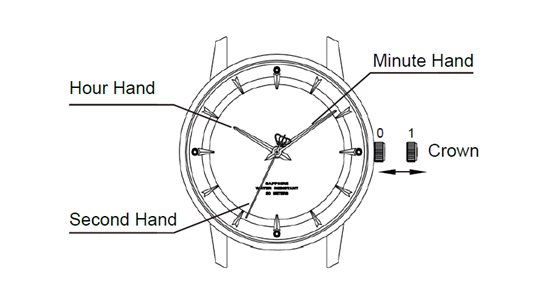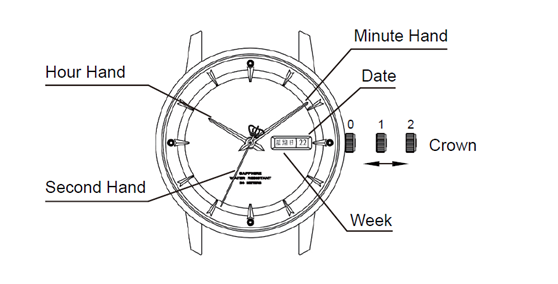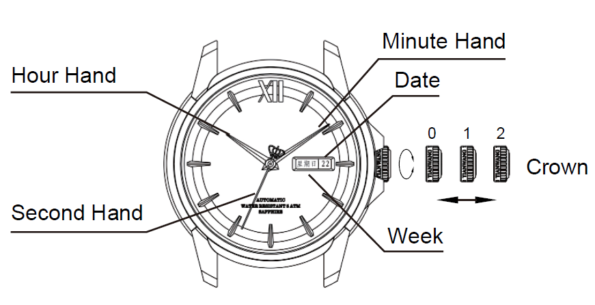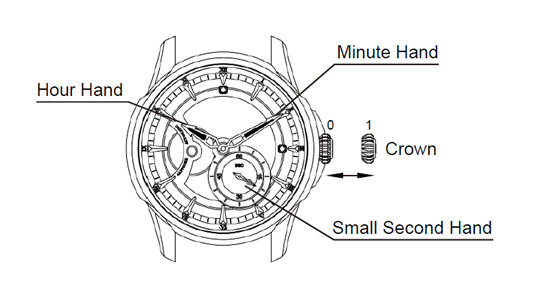Welcome to our store.
Watch Care
(1) Fear of corrosion
The most afraid of being with mothballs and insect repellents, because they will volatilize chemicals to corrode the watch’s waterproof ring and even the movement, which are fatal to the watch.
(2) Fear of magnetic field
Try to stay away from TVs, stereos, microwave ovens and other things with magnetic fields, because watches contain iron, they will interfere with the operation of the watch, resulting in inaccurate walking.
(3) Fear of impact
The watch is a metal product, but it is also afraid of hard objects, which will cause scratches at light, or damage to the crystal or movement damage and paralysis at worst.
(4) Swimming / bathing are prohibited
Occasionally washing hands in life, rain splashed water is generally not a threat to the watch, but swimming, bathing or don’t wear it, unless the watch’s waterproof depth is more than 200m! Do not operate the watch’s buttons and adjust the crown in water.
(5) Battery Replacement
If the battery of the quartz watch is dead, please replace the battery in time! Otherwise, the battery alkali will leak, which will erode the movement of the watch and cause damage.
(6) Please clean the strap/case regularly by a professional watch master; If it is a leather strap, avoid contact with moisture, moisture, cosmetics, etc., and avoid exposure to the sun.
(7) Do not adjust the calendar and day of the week between 21 o’clock and 3 o’clock on the watch, so as to avoid damage and inaccuracy of calendar jump; If you need to adjust the time, please try to turn the pointer clockwise to avoid damage to the movement; If the activity of the mechanical watch is low, please replenish its power reserve energy by winding the watch.
(8) The error of mechanical watch every 24 hours is normal within -20~+50 seconds; The monthly error of quartz watches within +/- 15 seconds is normal.
Instructions
Two-hand/Three-hand Calendar-free Quartz Watches

Operating Introductions:
Position “0”: the watch’s regular operating position.
Position “1”: rotate the crown to adjust the hour and minute hand.
Precautions:
When the crown is in Position “1”, it’s in the timing and adjusting status. In order to prevent water from entering the watch and destroy the movement, the crown must be pushed back to Position “0” after adjustment.
Time Setting:
When the second hand runs to the position of 12 o’clock, pull the crown to Position “1”. When the second hand stops, the crown of this two-hand quartz watch can be directly pulled out to Position “1” for the second hand’s missing.
Rotate the crown clockwise and adjust the hour and minute hand to the correct position. For two-hand quartz watch, to ensure the minute hand’s accuracy due to its movement and wheel features, its minute hand can be adjusted two minuets ahead of the exact time while setting time and then the crown can be pushed to Position “0”.
After adjusting the hour and minute hand, push the crown back the Position “0” when it runs to the position of 0 o’clock based on the standard time. Then the second hand begins to run and the whole time setting process is completed.
Single-calendar/Double-calendar Quartz Watches

Operating Introductions:
Single-calendar watch has the function of calendar-indicating.
Double-calendar watch have the function of day-indicating and calendar-indicating.
Position “0”: the watch’s regular operating position.
Position “1”: rotate the crown to adjust the day clockwise (two options of the indicating words in both Chinese and English are available). Rotate the crown anticlockwise to adjust the date. When the crown is in such position, adjust the watch’s date and day to the quickset position.
Position “2”: Rotate the crown to adjust hour and minute hand.
Precautions:
The crown’s rotating direction of certain watch types is contrary to the above operation while adjusting the date and calendar.
When the crown is in Position “1” and “2”, it will be deteriorated due to external force and its water-resistant function will be affected. In order to prevent water from entering the watch and destroy the movement, the crown must be pushed back to Position “0” after adjustment.
The watch’s date and day indicating’s automatic adjustment happens during 21:00-3:00. Therefore, the quickset date and day adjustment is prohibited during such period, or the movement may be destroyed.
Date setting is based on 31 days/month while the movement leaves the factory and therefore, manual adjustment is required when it comes to a solar month of 30 days.
Setting of Time, Date and Day:
Since the movement itself can’t identify the position of 12 o’clock is in the early morning or at the noon, so the crown should be firstly pulled out to Position “1”. Quickset and adjust the date and day one day ahead of present date and day (For example: today is 27, Monday, then the watch should be adjusted to 26, Sunday).
When the second hand runs to the position of 12 o’clock, pull out the crown to Position “2” and it stops. Rotate the crown clockwise and rotate the hand and minute hand to adjust the date and day indicating. When the date and day indicating turns to present time, the explicit time now is in the early morning. Then, adjust the hour and minute hand to the correct time.
After adjusting the hour and minute hand, push the crown back the Position “0” when it runs to the position of 0 o’clock based on the standard time. Then the second hand begins to run and the whole time setting process is completed.
24-hour Analogue Watches

Operating Introductions:
Position “0” is the original position.
Pull the crown to Position “1” clockwise and rotate it to adjust the calendar.
Pull the crown to Position “2” to adjust the time and rotate it clockwise to adjust the day.
Press Button “A” to adjust the month.
Press Button “B” to adjust the 24-hour hand. Precautions: the month’s quickset can’t be adjusted during the day 31 and 1.
Ordinary Mechanical Watches

Operating Introductions:
Position “M0”: the spiral crown is completely locked (the non-spiral crown doesn’t have such position. Position “0” is just its winding as well as its water-resistant position.Position “0”: manual winding position (rotate the crown clockwise)
Position “1”: rotate the crown clockwise to adjust the week and anticlockwise to adjust the date.
Position “2”: rotate the crown to adjust the hand and minute hand.
Small-second Ordinary Three-hand Watches

Operating Introductions:
Rotate the crown clockwise at Position “0” to wind up.
Pull out the crown from Position “1” to this position so as to adjust the hour and minute hand.
Precautions:
The quickset function of several watch types can be adjusted by pulling the crown again and again between Position “1” and Position “2”. One pull means a day.
The watch’s date and day indicating’s automatic adjustment happens during 21:00-3:00. Therefore, the quickset date and day adjustment is prohibited during such period, or the wheel within the movement may be destroyed.
The crown’s rotating direction of certain watch types is contrary to the above operation while adjusting the date and calendar.
For watches that aren’t used for a long time, they have to be manually winded up about 30 circles as the energy reserve in their initial run so as to acquire better timekeeping property.
The timekeeping error of mechanical watches is calculated by per day’s error and it can’t be accumulated. Adjusting the watch once a week in accordance with the standard time is recommended.
Winding Instruction:
The automatic mechanical movements adopted by the Company are all equipped with the function of manual winding. Calculated in terms of the regular energy conversion: wearing it for over 8 hours per day can ensure enough energy to keep the watch in a good running condition. Once the watch is in static condition or has relatively small daily active amount, 30 circles’ manual winding (i.e., rotate the crown clockwise) is preferred to supplement the required energy. Watches with energy hands can determine
their own winding condition based on the time indicated via the hands.
Manual winding mechanical watches should be winded up everyday in a fixed time so as to ensure that there is enough energy for its running in the movement.
Second-stopping Introductions:
· Mechanical watches can be divided into second-stopping and non-second-stopping ones. Watches with a second-stopping function have a higher timekeeping accuracy than non-second-stopping ones.
· The hands of second-stopping watches will stop running when the crown is pulled out from the hand setting position, which means count of hand.
· Non-second-stop watches don’t have such function, but it doesn’t affect its timekeeping accuracy.
Setting of Time, Date and Day:
Rotate the crown anticlockwise to remove it from being completely locked. Adjust correspondingly when the crown is pulled out.
Since the movement itself can’t identify the position of 12 o’clock is in the early morning or at the noon, so the crown should be firstly pulled out to Position “1”. Quickset and adjust the date and day one day ahead of present date and day (For example: today is 27, Monday, then the watch should be adjusted to 26, Sunday).
When the second hand runs to the position of 12 o’clock, pull out the crown to Position “2” and it stops (the movement of some mechanical watches doesn’t have non-second-stopping hand, so you need to set the date and day indicating slowly. When the date and day indicating turns to present time, the explicit time now is in the early morning. Then, adjust the hour and minute hand to the correct time.
After adjusting the hour and minute hand, push the crown back the Position “0” when it runs to the position of 0 o’clock based on the standard time. Then the second hand begins to run. Presse the crown slightly and rotate it clockwise to get it locked to Position “M0” completely. The whole time setting process is now completed.
Date setting is based on 31 days/month while the movement leaves the factory and therefore, manual adjustment is required when it comes to a solar month of 30 days.
